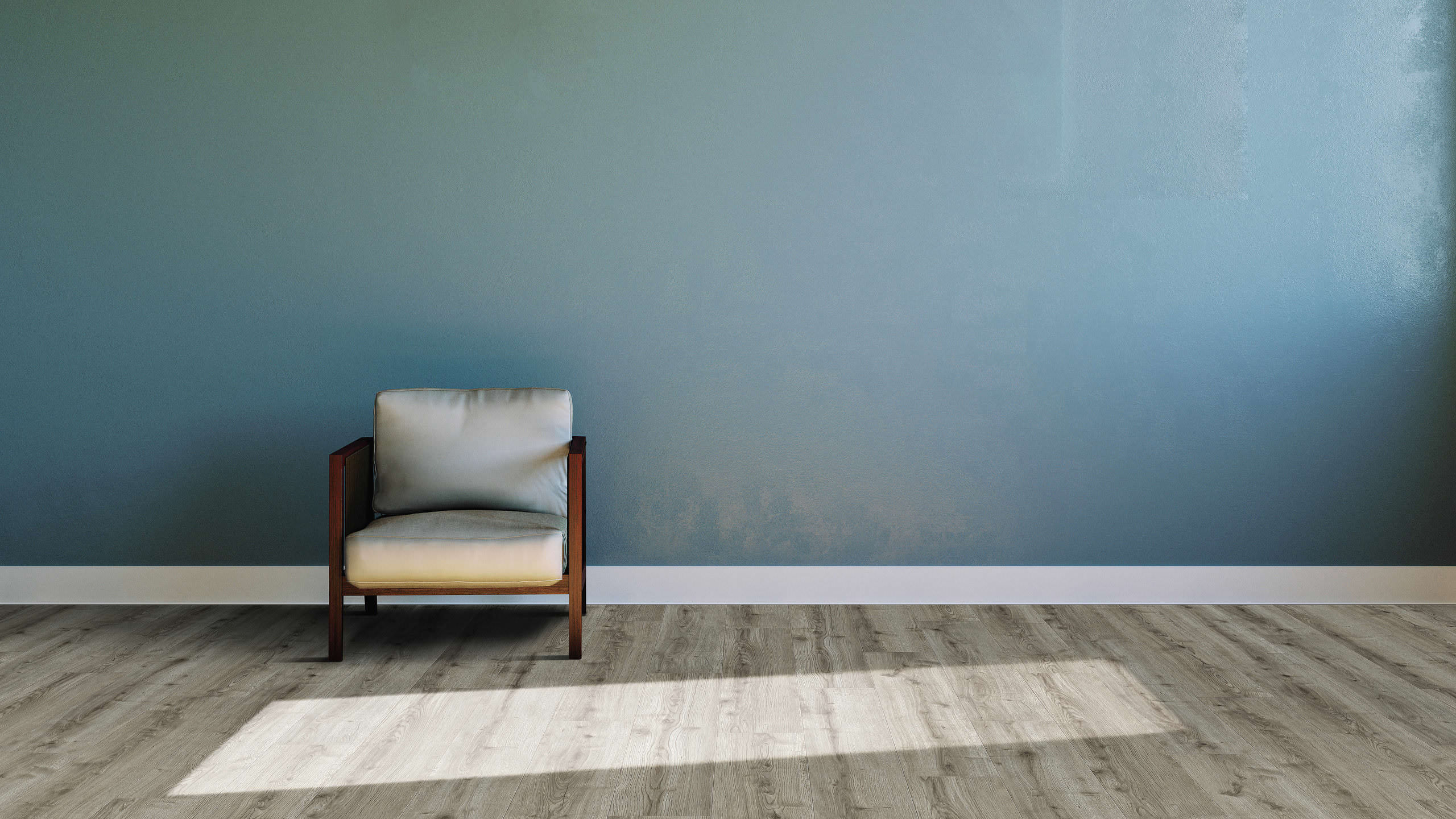Click and ready - our installation system makes it easy for you
Laying design flooring for do-it-yourselfers
Regardless of whether it is a new build or a rented flat: You can install most DISANO design floors yourself without any prior knowledge. With floating installation, you hardly need any tools and do not have to work with glue.
What other installation methods are there? How do you go about installing design flooring? In the following, you will find information on how to get started with installing design flooring yourself.
The topics at a glance
There are topics that you should consider in advance, such as the condition of the subfloor and which installation direction is best. But also during the installation itself, there are things worth knowing about insulation underlays and the special features of floating installation as well as full-surface gluing. Special topics on accessories, such as skirting boards, but also on special installation situations in bathrooms and on underfloor heating are explained.
The nature of the subfloor and its preparation
Before you can start laying the first plank, you need to prepare the subfloor. You can install HARO design flooring on cement screed, mastic asphalt or V100 laying chipboard, for example. The subfloor must be solid, dry and even. This means: If the screed is new, it must dry for six to eight weeks. Think about additional moisture protection for screed and when laying on underfloor heating. We recommend a 0.2 millimetre thick PE foil.
What are the special requirements of the subfloor in your home? Your specialist dealer will be happy to advise you on this. However, we have also put together some videos on our YouTube channel that will help you.
What should you consider when laying the flooring?
The direction of installation influences the effect of the room. Think about the direction before you start laying the floor: What is the main source of light in the room? Examples of this are the patio door or a window with two casements. Lay the planks lengthwise to the incoming light to achieve a harmonious look and to conceal the joints.
Whether large or small: Find out here how you can visually influence the proportions of the room with the installation direction of the floor covering.
Is an additional insulation underlay necessary?
Feather-light function: impact sound insulation reduces room and footfall noise. This is not only pleasant for your neighbours. The optimised walking comfort also increases your feel-good factor DISANO LifeAqua, ClassicAqua and SmartAqua have integrated insulation made of a highly compressed cork board. With these floors, you do not need an additional insulation underlay. For floating installation of DISANO Saphir, use the insulation underlay HARO Silent Grip: This is an acoustic insulation underlay based on natural fillers. The underlay is also suitable for installation over underfloor heating and cooling.
Floating installation: "Just do it" for do-it-yourselfers
A floor covering is a floating installation if it is not glued to the subfloor. The advantages? You can implement the project quickly and precisely. The innovative Top Connect connection means that the floor can withstand even heavier loads. You can walk on it immediately after installation. Nevertheless, it can be removed again quickly in the event of a move.
The installation tools: You don't need glue or adhesive. A pencil, folding rule, saw and a little DIY skill are all you need. Thanks to the Top Connect installation system, laying is a click away: angle in, press, done. Just like parquet or laminate.
How is designer flooring installed?
- Start with the first row of planks in the right-hand corner of the room. Lay the first plank with the tongue side facing the wall and insert spacer wedges between them.
- Lay the second plank to the left and press it into the first at the head end.
- Finish the first row by pressing all the other planks into the previous plank from above at the head end. You will probably have to shorten the last plank of the first row. It should have an expansion gap of 10 to 15 millimetres to the wall.
- Start the second row on the right again: Use the leftover piece from the previous row for this. Angle the plank lengthwise with the tongue side facing the wall. You only need to apply slight pressure. Only then lower the plank at the head end and lock it in place with light pressure.
- Lay all further rows as in steps 1 to 4.
- Cut the planks for the last row lengthwise so that an expansion gap of 10 to 15 millimetres remains.
- Have you finished laying the flooring? After fitting skirting boards and profiles, your flooring is ready for your first steps.

You can find more information, such as detailed instructions and advice on laying for heating pipes, in our videos.
What is full-surface bonding?
Our Top Connect installation system is also suitable for full-surface bonding. With this type of installation, you connect the floor covering to the subfloor. This is particularly useful in heavily used rooms, such as in commercial areas. The floor is even more robust because the material can work less. Bonding also optimises footfall and room sound, and in rooms with many nooks and crannies, you can be sure that your floor covering will provide an even surface for well-being.
You don't want to glue the design flooring yourself? Hire a professional.
Hint:
DISANO Project must always be glued down, preferably by a professional. You can find installation professionals in our dealer index or via your specialist dealer.
Why do you need skirting boards and profiles?
If you install DISANO yourself, remember to also install skirting boards and profiles: The former give the room contour and make the contrast between the covering and the wall more discreet. And above all, they conceal the necessary expansion gap between the floor surface and the wall.
Transition profiles function like bridges between floors or rooms. A harmonious surface is created. Adjustment profiles are available for connecting floors of different heights.
Whether with moisture protection or without, whether with decor in oak* white or walnut*: Our accessories are visually and technically coordinated with the design floors. For a well-rounded flooring experience.
What about the installation of design flooring DISANO in the bathroom?
The days of cold, white tiles in damp rooms are over: you can now install many types of flooring in the bathroom or kitchen. From our design floor range are DISANO Saphir and DISANO Project are waterproof and therefore particularly suitable.
Thanks to the integrated wetness protection, you can also use DISANO SmartAqua, LifeAqua, WaveAqua or ClassicAqua in the DISANO ClassicAqua in the bathroom. A prerequisite for installation in damp rooms is full-surface adhesion for all floors. To ensure that the floor covering really fits perfectly and moisture cannot penetrate, you should enlist the help of a professional.
Suitable DISANO for laying on underfloor heating or cooling?
The planks have a multi-layer structure. Their shape remains stable even under temperature loads. In addition, they have a low thermal resistance. Therefore all DISANO Design floors are suitable for installation on underfloor heating or cooling.
Before you start with the floating installation on an underfloor heating system, you must lay a 0.2 millimetre thick PE film on the subfloor. This protects against moisture. Please also refer to the instructions in the installation manual. It is also possible to glue the floor to the underfloor heating. You do not need a foil for this.
Are you proud of your new floor? To keep the joy alive, we have put together tips for floor care.



